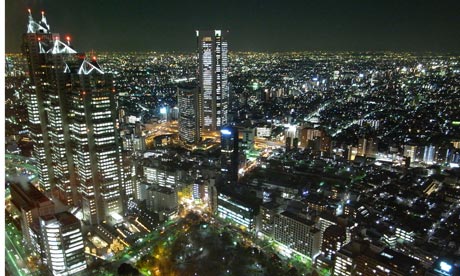
Overwhelming and overcrowded yet efficient and energising, the Japanese capital charms and terrifies in equal measure says Nick Coldicott
It’s the world’s most populated metropolis, a powerhouse of finance, fashion, art, industry and – according to Michelin and others – the dining capital of the world. Tokyo has come of age as a must-visit destination.
Yes, it’s congested, and yes, it’s draped in neon, wrapped in etiquette and can be terribly expensive, but as long as you’re not expecting a calm experience, this city will dazzle, baffle and charm you in equal measure.
The pace of Tokyo can be breathtaking, but so can its efficiency. No other city of this size works quite so well, nor manages to be this civil. Crime is incredibly low, trains and buses turn up on time, and even among crammed-in rush-hour passengers, tempers almost never fray.
The bad news is that there are more rules than you could hope to learn; the good news is that nobody expects you to learn them. The one big, break-at-your-peril social edict is that you must take off your shoes when entering Japanese-style restaurants, izakaya (pubs) and anywhere else you see a shoebox at the entrance. Other than that, you’ll usually be forgiven for your faux pas.
Get in the mood for Tokyo by reading The Encyclopedia of Japanese Pop Culture (Weatherhill, 1997) by Mark Schilling. Though written over a decade ago, it still stands as the best intro to Japan’s quirky preoccupations.
Tokyo is served by two major airports; chances are you’ll arrive at Narita, 60km east of Tokyo in Chiba Prefecture. Plan plenty of time for immigration, and be prepared to offer your digits for fingerprinting.
If you’re looking to pick up a rental mobile phone, this is the place to do it: look for the Softbank kiosks in the arrival halls.
Don’t even think about driving. Taxis might be convenient in many cities, but this is the nation of superb public transport, and you’ll get into town much quicker, not to mention ¥35,000 (£260) richer, by taking the new Skyliner to Ueno Station. It takes less than 45 minutes and costs ¥2,200 (£16). If staying on the west side of town, the Narita Express is more convenient. It takes twice as long as the Skyliner, but drops at Shinjuku or Ikebukuro stations.
Feeling flush? You can reach the city by helicopter. The MCAS chopper will shuttle you from Narita to a helipad in central Tokyo, where a limo will whisk you to your hotel. At ¥45,000 (£333) one way, it’s only slightly pricier than a cab.
Traditional Japanese? Try a ryokan. Creature comforts and pampering? Tokyo is now blessed with more luxury chain hotels than it probably needs. Saucy fun? Tokyo’s love hotels can be a giggle. Cheaper the better? Try a capsule hotel, though one night might be enough. Self-catering? Forget about it – you’ll want to eat out as often as possible.
If you like your city on a plate, pick a hotel in Shinjuku, Shibuya, Roppongi or Ginza. If you want something a little calmer and cheaper, Ueno or Asakusa are a good bet.
Top-end: The Peninsula, between the luxury playgrounds of Ginza and Marunouchi, by the Imperial Palace, has a stunning interior by design star Yukio Hashimoto. Doubles from an eyewatering ¥60,000 (£445).
Mid-range: Hotel Niwa, a former ryokan reborn as a hotel in 2009, kept the Japanese design touches, elegant service and peaceful location. Doubles from ¥12,000 (£89).
Budget: K’s House Tokyo Oasis is a Japanese-accented hostel in historic Asakusa, with comfortable doubles, clean dorms, free WiFi and a fully equipped kitchen. Doubles from ¥4,400 (£33) pp, dorms from ¥2,900 (£21).
Pick up a Suica or PASMO magnetic travel card at any train or metro station. These are valid for most kinds of public transport, including buses, and will take the pain out of figuring out fares.
Awake early with jetlag? One of Tokyo’s top tourist attractions is over by breakfast. To get a ticket for the Tsukiji fish market’s famous tuna auction, head there before 5am.
Later, head to Asakusa, where you’ll find Tokyo’s oldest Buddhist temple, Asakusa Kannon, as well as streets full of time-warp shops and eateries. Then head three stops south on the Ginza metro line to Ueno, where you’ll find the city’s liveliest street market, Ameyoko, as well as the treasure-laden National Museum.
If you’ve come for the sensory assault of modern Tokyo, head to Shibuya, Shinjuku or Harajuku.
In Shibuya you’ll find the world’s busiest pedestrian crossing; in Shinjuku, the world’s busiest train station leading to those streets of neon-edged skyscrapers; and in Harajuku you’ll find outrageous street fashion and snap-worthy architecture ranging from a Kenzo Tange masterpiece (the Yoyogi National Gymnasium) to the city’s largest shrine, Meiji-jingu.
Save the evening for some serious eating and drinking. If your budget is big enough, try Ryugin for creative modern Japanese fare. At the other end of the spectrum, Kamiya Bar (Asakusa) is an institution that serves greasy Japanese pub grub with jugs of beer and its own bizarre liquor Denki Bran.
Stay. This is a city that gets better with each day. It’s a baffling cacophony at first, and stays that way no matter how long you’re here, but as long as you approach Tokyo not as a city to tick off famous sights, but as a pulsating metropolis to submit to, you’ll find it hard to tear yourself away.
Visit the city on a budget: 10 things to do for free in Tokyo | Inspire me... More
Tokyo tuna auction reopens to visitors | News... More
Tony Wheeler offers advice on Tokyo | Destinations... More
Take a culinary tour around Tokyo | Destinations... More
Japan announces record visitors numbers in 2010 | News... More